China Has More Than Balloons Snooping From the Skies
China’s Guo Wang, or ‘national network,’ will potentially span the globe with a network of low-orbital satellites providing broadband connectivity.

China’s spy balloons are not the only object the Chinese are sending high above America and other countries peering into their secret defenses on the ground.
Far more serious, the Chinese are operating hundreds of broadband internet satellites — not only for communication purposes, but also for spying on what we’re doing to defend ourselves.
The Chinese operation was first named GuoWang, but now, more understandably to most of us, it’s called China SatNet. It should, when they’ve fired up enough of these things, see far more than was visible by any hook-up with a balloon.
Actually, China already operates China Telecom, China Mobile and China Unicom, covering “most big cities and even more sparsely populated regions,” according to Larry Press, professor of information systems at California State University. But, if a “constellation” of thousands of satellites were working as planned, he notes, “China could serve other nations as part of its Belt and Road global infrastructure initiative.”
All of which makes the hullabaloo over the balloon that was shot down by an American Air Force jet look a little overblown, aside from its sheer entertainment value. It’s China’s venture into the space race, at altitudes way higher than the 60,000 feet at which the balloon traversed North America, that we have to worry about.
The website Rest of the World reports “China’s satellite internet vision finally became clear in 2021 when Bao Weimin, a director of the country’s main space industry contractor, China Aerospace Science and Technology Corporation, confirmed that efforts were being centralized under an entity known as “Guo Wang,” or “national network.”
The International Telecommunications Union, according to the report, received a filing two years ago seeking approval for nearly 13,0000 satellites for GW, Guo Wang, all of which “revealed the Chinese space industry’s global vision for a broadband satellite internet network that could stretch worldwide.”
It’s inconceivable, if China’s inroads into American corporations through stock purchases, and university campuses, via language programs, fellowships and scholarships, that none of these satellites would serve intelligence purposes. At altitudes far higher than a mere balloon or drone, some of them are presumably already serving China’s political and military machine.
The Chinese satellite system is still nowhere near the dimensions of Elon Musk’s SpaceX, and it’s not easy to get by barriers imposed by America and its allies, but the Chinese have already put several hundred of these satellites into orbit. How far the Chinese can go to achieve their ambitions, though, is open to speculation.
“Chinese state-owned enterprises clearly do not have the capacity to produce and maintain satellites for a mega constellation,” writes Mr. Press at Cal State. “One, or perhaps a coalition of private companies, could be called upon to manufacture GuoWang satellites.”
But catching up won’t be easy. “China has relatively poor access to global ground infrastructure,” says Mr. Press. “As with launch and satellite manufacture, there are promising start-ups, but China lags established companies.” Moreover, he notes, China “is precluded from using their products by the current technology cold war.”
And then, he adds, there’s President Xi Jinping’s “Made in China 2025 policy” – a reference to Mr. Xi’s goal for China to be able to produce all it needs for catching up in the high-tech competition with America, Japan and other advanced rivals. No one doubts, though, the Chinese will keep trying – in ways far more sophisticated than what the Chinese still insist was a “weather balloon” that went astray.

